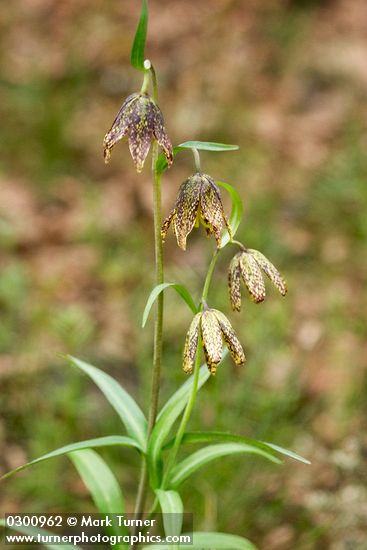Fantastic Fritillaries
Our Koma Kulshan chapter of the Washington Native Plant Society hiked up through the new Baker Mountain Ranch Preserve on Lummi Island last Saturday to begin a plant survey for the Lummi Island Heritage Trust, which recently acquired the property. There were 13 of us in the party, more than the LIHT prefers, which meant many eyes to spot the flora and make identifications. Most of the plants were common so books didn’t have to come out of packs very often.

At the end of our hike, where the Baker Mountain Ranch Preserve adjoins DNR land, are a couple of small balds. These are areas with thin rocky soil, facing west, that bake in the summer sun. Plants that grow here bloom early before the soil dries out. The choice find on Saturday was a spectacular clump of Chocolate Lilies (Fritillaria affinis). They’re not rare, but they only grow in specific habitats so you have to know where to find them. The photo here wasn’t made on our Saturday trip, but shows what the plant looks like. There are more photos on my Pacific Northwest Wildflowers website.
Chocolate Lilies grow from bulbs. They’ll slowly multiply, like daffodils in your garden, if left undisturbed and the growing conditions are right. However, each plant doesn’t necessarily bloom every year, so you may think your favorite lilies have disappeared when in fact they’re just taking a year off.
We also found nice patches of Oregon Fawn Lily at the edge of the bald, along with Rosy Plectritis, Spring Gold, and Menzies’ Delphinium. Bright orange Harsh Paintbrush dotted the steep cliffs in a couple of places and was also along the trail near the top. Camas and Oregon Sunshine weren’t in bloom, but easily recognizable. We pulled lots of the invasive Scots Broom from one site and packed it out so the plants couldn’t take root again somewhere else.
Another plant of interest was Douglas Maple (Acer glabrum var. douglasii). On the BRP it completely replaces Vine Maple, which is the common understory tree in Bellingham and elsewhere on mainland lowland forests around Puget Sound.
In all, we listed about 135 plants. There were others that we could see but not identify until they come into flower later in the season, including some orchids we’re very curious about. We plan to return in early July.


There was some fritillaria affinis blooming on Goose Rock last weekend.